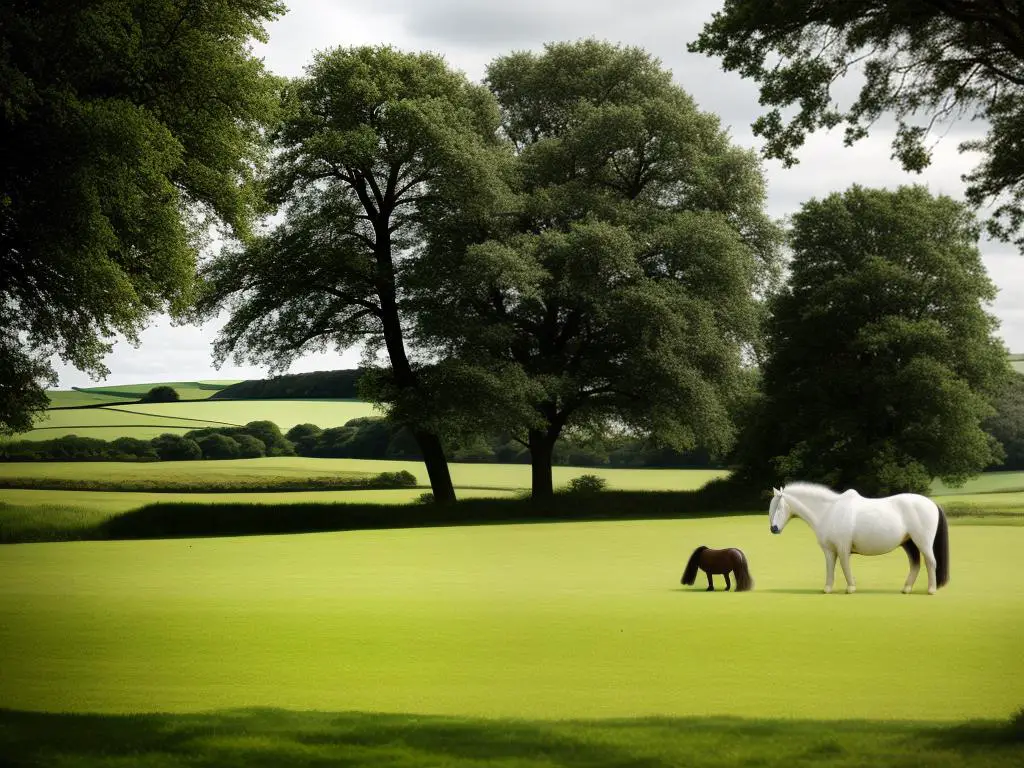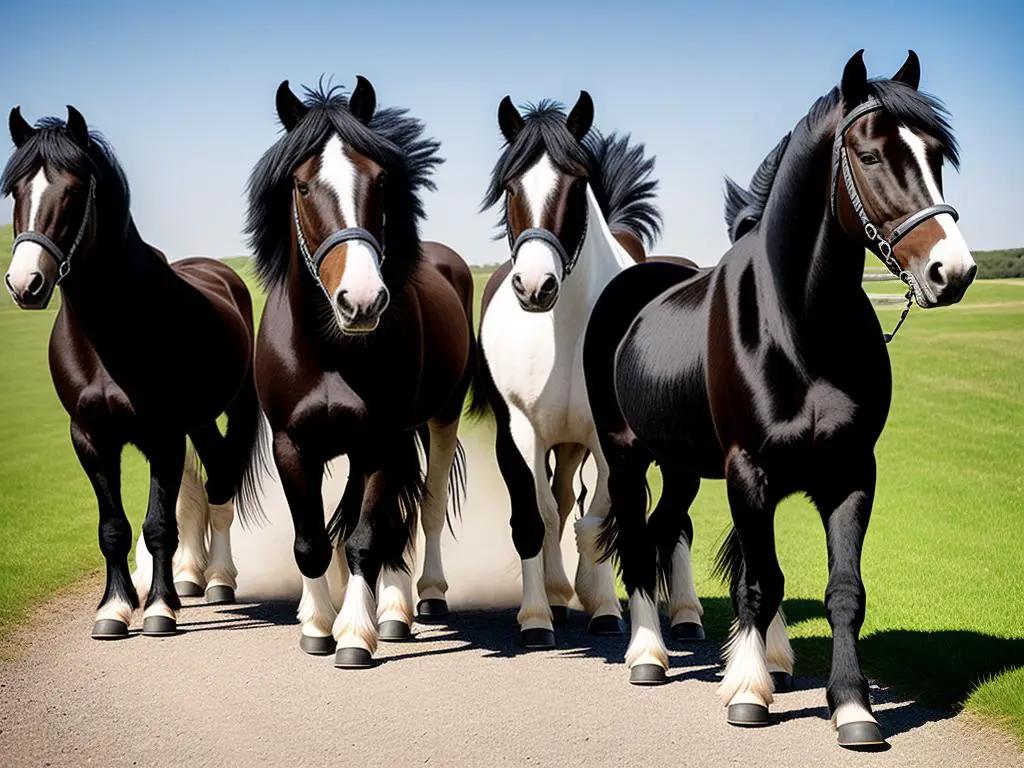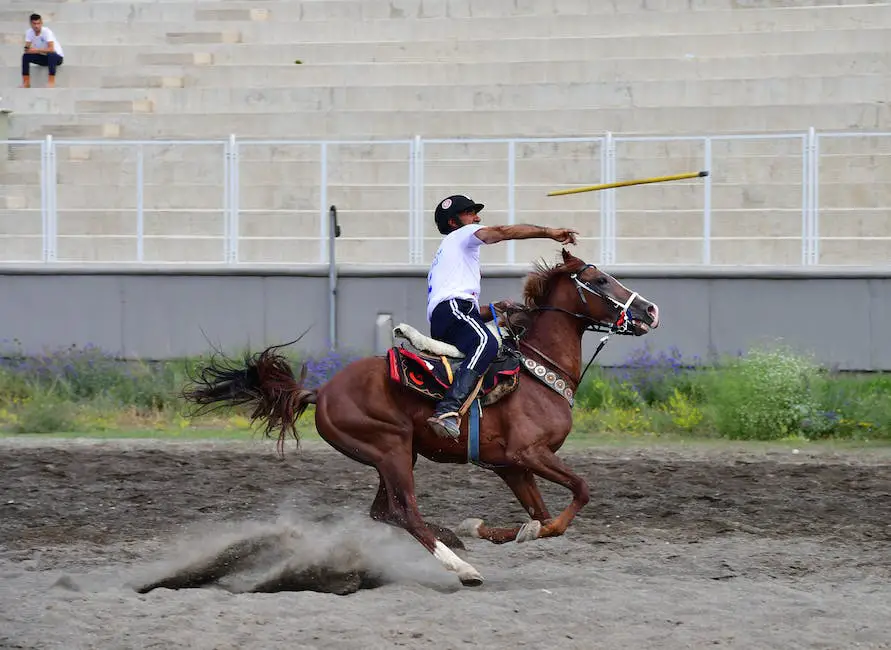Renowned for their immense strength, gentle temperament, and stunning beauty, horses have served humanity in countless ways throughout history. Among the many breeds of horses, the Shire Horse and the Percheron stand out due to their unique physical characteristics, rich history, and high versatility. These two breeds, originating from different parts of the globe, have carved out their own unique places in human history. This piece delves deep into the world of Shire Horses and Percherons, their origins, physical characteristics, temperaments, health and lifespan, and and their current roles in society.
Table of Contents (Horspedia)
Origin and History
Shire Horse: History and Origin
The Shire horse is a breed of draught horse that originates from England. Bred for their unimaginable strength and towering stature, Shire horses were the workhorses of the Middle Ages, used primarily for farming purposes, pulling carts, carrying knights into battle, and heavy hauling. Once known as the “Great Horse”, the ancestry of Shire horses can be traced back to the Black Horse of Flanders, which was used widely in medieval England for its highly prized tactical capabilities in warfare.
The Shire breed as we know it today began to take shape in the mid-18th century, when breeders started crossbreeding local draught horses with Dutch Friesian horses. The subsequent offspring, often referred to as “Bakewell Shires,” exhibited a combination of power, agility, and gentleness, defining the characteristics of the breed.
Notably, the Industrial Revolution in the 19th century saw an increased reliance on Shire horses for heavy draught work in cities, such as pulling omnibuses and heavy carts filled with goods. However, the advent of mechanization in the early 20th century greatly reduced the need for these mighty horses, threatening their population and existence.
Percheron: An Introduction and Overview of Its Origins
The story of the Percheron, a horse native to the Huisne river valley in France, including the historical region of Perche, intertwines closely with the narrative of the Shire horse. Yet, the exact lineage and origins of the Percheron remain somewhat elusive due to the scarcity of reliable early breed records.
Despite the scant recorded history, breed development theories often cite Arabian bloodlines. Such theories speculate that the Percheron likely descends from Moroccan or Moorish horses that journeyed to Europe during the 8th century. Another plausible ancestor is the Boulonnais horse, a domesticated French draft breed utilized in warfare, agriculture, and goods transportation. These speculated Arabian and Boulonnais influences could account for the Percheron’s distinctive stamina, muscular strength, and its comparatively refined and lighter build relative to other draft horses.
The Percheron secured its place in the limelight during the 19th century as it became a common sight on the streets of Paris for urban transportation. This popularity led to significant exports to the United States later in the 1800s, where the breed was prized for similar roles in agriculture and transport. Despite the sizable population reductions following the advent of mechanization in farming and transportation, the Percheron has sustained a steady presence, due to its adaptability and utility in diverse areas, spanning from agriculture and logging to horse-drawn carriage services.

Physical Characteristics
Physical Traits: A Comparison between the Shire Horse and the Percheron
When considering draft horse breeds, the Shire and the Percheron stand out as prominent figures, recognized for their immense size and formidable strength. They played a crucial role in various contexts over the centuries, ranging from agricultural tasks and transportation to military applications. Though seemingly similar at first glance, each breed holds distinct physical attributes that differentiate them from each other.
Shire Horses
Dating back to the Roman times, the Shire horse is often considered one of the largest and strongest horse breeds in the world. Standing tall, on average, a male Shire horse (stallion) height ranges between 17 and 19 hands (approximately 68 to 76 inches), and a female (mare) stands around 16 to 17 hands (64 to 68 inches) tall.
In terms of weight, a mature Shire horse usually measures between 1,800 to 2,200 pounds. However, records show that some male Shires have even tipped the scale at a massive 2,400 pounds.
The coats of Shire horses traditionally come in black, bay, or brown, but grey Shires are also not uncommon. One of the distinguishing features of a Shire horse is its dense feathering around the lower legs, providing a flamboyant fluff over their large hooves.
One spectacular characteristic of Shire horses is their powerful, arching necks, which effortlessly hold high their long, noble heads. Looking at their overall appearance, Shires display a combination of raw power under control, gentleness, and hardiness.
Percheron Horses
The Percheron breed originates from the Huisne river valley in France and was developed during the medieval era. The average height of a Percheron ranges between 15.1 to 18.1 hands (around 61 to 73 inches), placing them a bit shorter than Shires on average.
Weight-wise, a mature Percheron might range anywhere from 1,900 to 2,600 pounds. Although this range overlaps with that of the Shire, it tends toward a slightly higher average weight, which is especially true for draft or farm work-style Percherons.
Percherons have a great variety of coat colors, including black and grey primarily, but you may also find bay, roan, chestnut and occasionally a sorrel Percheron. Unlike the Shire, Percherons are not heavily feathered, their lower legs are clean, elegant, and sport only a light feathering around the hoof, which further emphasizes their muscular legs.
In terms of their overall appearance, Percherons exhibit an air of elegance and agility that is distinctive to their breed. They are appreciated for their noble heads, intelligence displayed through their alert eyes, power-packed physique, yet a remarkably graceful gait for a large horse breed.
Both the Shire and the Percheron horses, known for their immense strength, have each played an important role in history and continue to hold a distinguished presence today. Similar, yet distinctly unique, they each boast a collection of traits that set them apart in the spectrum of horse breeds.

Photo by knl_photo on Unsplash
Temperament and Behavior
Shire Horse: The Gentle Giant
The Shire Horse, renowned for its strength and endurance, boasts a calm and gentle temperament. Traditionally, they have been employed for arduous tasks such as hauling heavy loads, fostering a legacy of patience, tenacity, and notable strength.
Despite their intimidating size, these gentle giants are known for their good-nature, intelligence, and innate willingness to learn. Their easy-going personalities make them suitable companions for a range of horse handlers, from the novice to the experienced, with careful consideration to their amiable power and size.
Adaptable and pleasurable to ride, the Shire horse stands as an excellent choice for those seeking a gentle yet resilient equine companion.
The Percheron: The Agile Workhorse
The Percheron, like the Shire Horse, originated as a warhorse. Over time, it became favored for its strength and stamina in hauling heavy goods. As such, these horses are characterized by their spirit and ambition.
Percherons are generally cooperative and gentle horses. They are intelligent and known to be quite quick learners, which allows their handlers to train them relatively easily. Despite their size, they’re notably light on their feet and can exhibit elegant movements when galloping or trotting.
Percherons also possess a strong instinctive drive and curiosity. This can make them more spirited and energetic than the Shire, so they might be a better match for experienced handlers who can guide the horse in a positive direction. The Percheron’s lively nature can also translate into energetic, enthusiastic responses during training, making them exciting horses to work with.
Comparing Shire and Percheron Horses
If you’re deciding between a Shire and a Percheron Horse, you’ll soon discover they both have their own unique traits. Shire and Percheron breeds are famous for their gentle, affable nature, hard work, and intelligence. However, the distinctions between their temperaments may make one breed more appealing than the other, depending on individual preference and experience.
The Shire Horse, often known for its laid-back demeanor, might be a more suitable choice for novice riders or those searching for a tranquil, patient horse. In contrast, the spirited and energetic Percheron could be a more fitting option for experienced handlers, offering more vibrancy and enthusiasm.
In the end, the decision between these two gentle giants depends on the individual requirements, competency, and personal preference of the horse owner or rider. Shire and Percheron Horses both make superb partners regardless of whether they’re being used for work, riding, or companionship.

Photo by mattseymour on Unsplash
Health and Lifespan
Understanding the Health and Lifespan of Shire Horses
Shire Horses from England typically live up to 25 to 30 years, although it’s not uncommon for some to live longer with the right care, even into their early 40s. Even though Shire Horses generally have substantial health, potential owners should be knowledgeable about a few breed-specific health conditions.
A prevalent health concern for Shire Horses is Chronic Progressive Lymphedema (CPL). This ailment causes consistent swelling and hardening of the lower legs, leading to discomfort and possibly lameness. In severe cases, it can cause significant physical changes.
As well as CPL, Shire Horses might be susceptible to Equine Metabolic Syndrome (EMS), an endocrine disease causing obesity, insulin resistance, and even laminitis, which inflames a horse’s foot’s soft tissues. Prevention of EMS requires owners to keep their horse’s diet and exercise routine regulated and balanced.
Percheron: Health and Lifespan
Percherons, originating from France, have a roughly similar lifespan to Shire Horses, with most living between 25 and 30 years. They are generally robust and healthy horses with few breed-specific health issues. However, like Shire Horses, Percherons can be prone to Equine Metabolic Syndrome (EMS).
They are also susceptible to equine polysaccharide storage myopathy (PSSM), a type of muscle disorder that can lead to stiffness, weakness, and collapse during exercise. It’s primarily managed through dietary changes and regular, light exercise.
Both breeds may also face typical health concerns that affect all horses, such as colic, arthritis, and various infectious diseases. Vaccinations, regular vet check-ups, a healthy diet, and plenty of exercises should form part of your horse’s routine to ensure they live a long and healthy life.
Both the Shire Horse and Percheron breeds are relatively long-lived and usually healthy, given their large size. Yet maintaining their optimal health requires an investment in regular veterinary care, a balanced diet, and a consistent exercise regimen. Whichever breed one chooses to adopt will ultimately depend on personal preference and specific needs.
Renowned for their robust and gentle nature, these breeds are ideally suited for a variety of purposes. However, their significant physical strength and gentle personality make them a top choice for many.

Uses and Roles Today
The Shire Horse: A True Gentle Giant
The Shire horse, originating from the United Kingdom, was initially bred for its unsurpassed size and strength, frequently harnessed for draft work in agricultural contexts and pulling hefty loads like coal carts or canal boats. To this day, this breed maintains the record as the tallest and largest horse in the world.
Nowadays, Shire Horses are well-known for their calm dispositions and versatility. They are frequently used in various commercial promotions, the filming of period pieces, forestry jobs, and numerous horse shows. Their commanding presence and gentle nature make them crowd favorites in horse shows across the globe, where they participate in dressage and hauling competitions.
While modern machinery has reduced their role in farming, Shire horses still have their place. They serve in tourism, offering horseback rides, and delivering beer traditionally at UK-based breweries. Many even become integral family members, treasured as lovable pets and riding companions.
Percheron: The French Workhorse
Percheron horses originated in France and have been praised as a draft horse breed that possesses agility along with immense strength. Like Shire horses, they were also historically used to haul large loads and perform agricultural duties, and were integral to transportation before the onset of the industrial era.
In the current era, Percheron horses continue to be utilized in various ways. These horses are favored greatly for their versatility and are seen throughout the world in distinctive roles such as carriage horses, police horses, and in competitive horse shows. Due to their good-natured temperament and high degree of intelligence, Percherons are used for therapeutic riding programs and equine-assisted psychotherapy.
Furthermore, Percheron horses are also used in several agricultural scopes even today. Both small and large farms utilize Percherons for plowing fields, pulling logs, and for general transportation. Their noteworthy strength is put to good use in plowing competitions as well.
In Comparison: Shire Horse vs. Percheron
Both Shire and Percheron horses have routed from a history steeped in hard work, from being war horses in the medieval period to being agriculture’s main driving force in past centuries. Now, they largely share their roles in contemporary society. Their majestic presence and composure make them popular show horses and their ability to carry heavy weights continue their utility on farms, even with modern machinery.
Yet, some differences exist. Percherons are often considered more agile and faster than Shire horses, making them more suitable for tasks requiring mobility, such as mounted police work. Conversely, the calm and serene temperament of Shire horses makes them more favorable for therapeutic riding programs and equine-assisted psychotherapy.
In essence, both the Shire horse and the Percheron play a significant role in today’s society, demonstrating their versatility, adaptability, and immense value. Whether on a farm, in a show ring, or simply as a loving pet, these breeds have firmly cemented their place in our hearts and our history.

Through a comprehensive exploration of the Shire Horse and the Percheron, it becomes evident that these breeds offer a fascinating insight into the remarkable journey and evolution of horses in human history. Their distinct physical attributes, temperaments, and health conditions reflect their particular history and influence their usages today. Whether they are contributing to various industries or enriching the lives of horse enthusiasts, Shire Horses and Percherons certainly hold a significant place in modern society. As we continue to forge our bond with these majestic creatures, we also continue to appreciate the extraordinary diversity and richness that they bring.